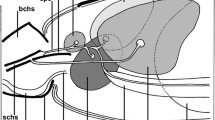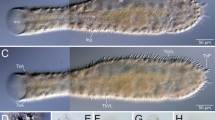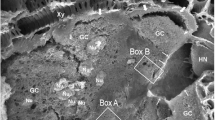Summary
Tubular systems present in bean leaf glands have been studied electron microscopically. Ordered arrays of small tubules (290 Å in diameter) arise from the endoplasmic reticulum in early stages of gland development and remain connected to it. Subsequently larger tubules (560–660 Å in diameter) appear among the smaller tubules and gradually replace many of them. The large tubules are not connected to the endoplasmic reticulum. They contain an electron dense material and their walls exhibit a patterned substructure. In older gland cells the bundles of large tubules run randomly through the cytoplasm. The relationship of the two types of gland tubules to conventional microtubules has been examined morphologically and experimentally. The small tubules have larger diameters and thicker walls than microtubules. Neither type of gland tubule is affected by low temperature or colchicine, or, in thin sections, by pepsin digestion. This suggests that these tubules are not closely related chemically to either cytoplasmic or ciliary microtubules. The two systems of tubules are closely associated with prominent protein vacuoles in the gland cells, but are not directly connected to them.
Similar content being viewed by others
References
Behnke, O., andA. Forer, 1967: Evidence for four classes of microtubules in individual cells. J. Cell Sci.2, 169–192.
Bonnett, H. T., andE. H. Newcomb, 1965: Polyribosomes and cisternal accumulations in root cells of radish. J. Cell Biol.27, 423–432.
Borisy, G. G., andE. W. Taylor, 1967a: The mechanism of action of colchicine. Binding of colchicine-3H to cellular protein. J. Cell Biol.34, 525–533.
1967b: The mechanism of action of colchicine. Colchicine binding to sea urchin eggs and the mitotic apparatus. J. Cell Biol.34, 535–548.
Burgess, J., andD. H. Northcote, 1968: The relationship between the endoplasmic reticulum and microtubular aggregation and disaggregation. Planta80, 1–14.
Burton, P. R., 1968: Effects of various treatments on microtubules and axial units of lung-fluke spermatozoa. Z. Zellforsch.87, 226–248.
Feder, N., 1960: Some modifications in conventional techniques of tissue preparation. J. Histochem. Cytochem.8, 309–310.
Lessie, P. E., andJ. S. Lovett, 1968: Ultrastructural changes during sporangium formation and zoospore differentiation inBlastocladiella emersonii. Amer. J. Bot.55, 220–236.
McIntosh, J. R., andK. R. Porter, 1967: Microtubules in the spermatids of the domestic fowl. J. Cell Biol.35, 153–173.
Mazia, D., P. A. Brewer, andM. Alfert, 1953: The cytochemical staining and measurement of protein with mercuric-bromophenol blue. Biol. Bull.104, 57–67.
Mollenhauer, H. H., 1964: Plastic embedding mixtures for use in electron microscopy. Stain Technol.39, 111–112.
O'Brien, T. P., 1967: Cytoplasmic microtubules in the leaf glands ofPhaseolus vulgaris. J. Cell Sci.2, 557–562.
Pickett-Heaps, J. D., 1967: The effects of colchicine on the ultrastructure of dividing plant cells, xylem wall differentiation and distribution of cytoplasmic microtubules. Develop. Biol.15, 206–236.
Porter, K. R., 1966: Cytoplasmic microtubules and their functions. In: Principles of Biomolecular Organization (Ciba Foundation Symp.) (G. E. W. Wolstenholme andM. O'Connor, editors). London: J. and A. Churchill Ltd.
Redman, C. M., andD. D. Sabatini, 1966: Vectorial discharge of peptides released by puromycin from attached ribosomes. Proc. nat. Acad. Sci. (U.S.A.)56, 608–615.
Reynolds, E. S., 1963: The use of lead citrate at high pH as an electron-opaque stain in electron microscopy. J. Cell Biol.17, 208–212.
Robbins, E., G. Jentzsch, andA. Micali, 1968: The centriole cycle in synchronized HeLa Cells. J. Cell Biol.36, 329–339.
Tilney, L. G., andJ. R. Gibbins, 1968: Differential effects of antimitotic agents on the stability and behaviour of cytoplasmic and ciliary microtubules. Protoplasma65, 167–179.
andK. R. Porter, 1967: Studies on the microtubules in Heliozoa. II. The effect of low temperature on these structures in the formation and maintenance of the axopodia. J. Cell Biol.34, 327–343.
Toselli, P. A., andF. A. Pepe, 1968: The fine structure of the ventral integumental abdominal muscles of the insectRhodnius prolixus during the molting cycle. II. Muscle changes in preparation for molting. J. Cell Biol.37, 462–481.
Author information
Authors and Affiliations
Additional information
This work was supported in part by grant no. GB-6161 from the National Science Foundation.
Rights and permissions
About this article
Cite this article
Steer, M.W., Newcomb, E.H. Observations on tubules derived from the endoplasmic reticulum in leaf glands ofPhaseolus vulgaris . Protoplasma 67, 33–50 (1969). https://doi.org/10.1007/BF01256765
Received:
Issue Date:
DOI: https://doi.org/10.1007/BF01256765




